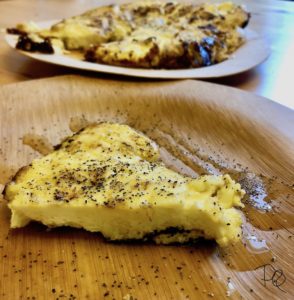
Ova Sfongia Ex Lacte
Ova Sfongia Ex Lacte is an ancient Roman recipe for pancakes that could be eaten for dinner or dessert and has proven to be quite a challenge to create. I was finally happy with my results on the 6th attempt! Many discuss that this dish turns out to be more like an omelette than a pancake. It does meet the criteria for a pancake (a mixture that creates a batter then fried), but you can certainly end up with some scrambled eggs if it is not timed just right or on the correct heat.
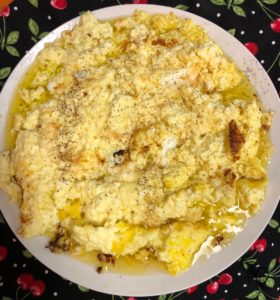
Messing up leads to these oily scrambled eggs
Apicius and Ova Sfongia Ex Lacte
The recipe used below is found in one of the oldest known cookbooks, Apicius, De Re Coquinaria. It was named after Marcus Gavius Apicius, a Roman merchant and epicure during the reign of Tiberius, early first century CE (common era). Apicius was a known glutton, a bit extravagant exploring exotic tastes and boasted luxurious dining. He was also rich which allowed him to do much of what he wanted and in the end played a part leading to his demise.
The exact history of the cookbook is not very straightforward given that there were several persons around that time with the name Apicius. The book, likely compiled over the next 4 centuries, is a collection of about 400 recipes from the Roman Empire. The most notable English translation is by Sally Grainger and Christopher Grocock in 2006 but the earliest is by Joseph Dommers Vehling in 1936.
Ova Sfongia Ex Lacte recipe:
- 8 eggs
- 600mL milk
- 100 mL oil
- a little bit of honey
- a little bit of ground pepper
Mix eggs, milk and oil until you have a pancake dough. Fry in a pan and serve topped with honey and a little pepper.
Cooking temperatures and times were not handed down in the cookbook leaving the true outcome of how this recipe was during the time of the ancient Romans a bit of a mystery. But as we have seen with other pancakes, the key to success is longer cook time over lower heat.
I took inspiration from the frittata (Italian fried eggs) and Spanish tortilla (fried eggs with potatoes), to come up with how I thought the ancient Romans would have made this dish. I also tried to use close to authentic ingredients and cookware.
A little more Ancient Roman History
The widespread use of olive oil in Ancient Rome gives us a clue that this recipe will take much longer than the average 3 minutes for a four inch traditional American buttermilk pancake. Cooking for longer time at medium heat will avoid burning the olive oil. The burning point or smoke point of olive oil is generally between 350 and 410 deg F so a gas stove burner should be on medium heat.
An ancient Roman frying pan, sartago, was likely a flat pan either round or oblong made from bronze or iron. I first tried this recipe without thinking about this, and used my stainless steel pan, but it stuck horribly. I then tried with cast iron which allowed for less sticking and ultimately, success. You will need a thin, narrow metal spatula to lift the sides and bottom prior to flipping to ensure it will not stick.
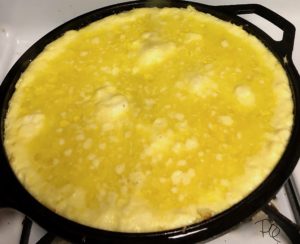
Appearance at 20 minutes, sides should start to become more firm
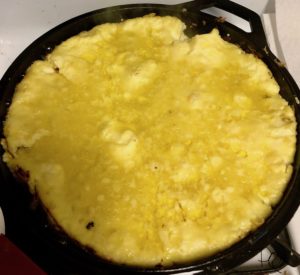
Ova Sfongia Ex Lacte at 30 minutes after lifting sides and scraping bottom with thin metal spatula
Likely cow’s milk was used for this dish but since sheep and goats milk was also used or even preferred during this time period, I tried goat’s milk on my second attempt. There wasn’t a difference in consistency that I could tell. There was just a slight flavor difference and the “goatiness” likely depends on the brand of milk used.
Rich ancient Romans would eat off of metal plates, the plebians off of wooden plates. At this time, I do not have any metal plates so wooden it is for our photos. As utensils were expensive, spoons were used by ancient Romans primarily for soup and all other foods were cut up to finger food size. If you’d like to be a part of the richer class, you could have a party of 8 and all lie down on your sides on plush sofas while you eat your OSEL and perhaps wash it down with some watered down wine.
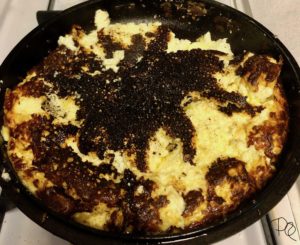
After the first flip, not perfect, but lots of character
Let me know if you give this a try!
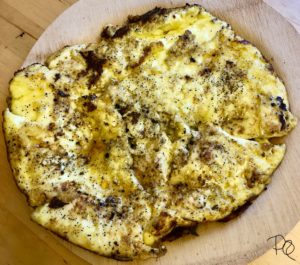
Final flip of Ova Sfongia Ex Lacte. Looks like an egg pancake!
References:
Pancake – A Global History by Ken Albala
http://penelope.uchicago.edu/, giulana-oliveoil.com, chefshalhoub.com, Savor – podcast, smartkitchen.com, ducksters.com
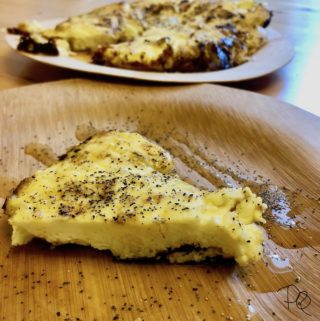
Ova Sfongia Ex Lacte
Equipment
- cast iron pan, mixing bowl, whisk, thin frosting knife or other thin narrow metal spatula
Ingredients
- 8 eggs
- 600 mL Whole Milk
- 100 mL Extra Virgin Olive Oil
- a little bit of honey
- a little bit of ground black pepper
Instructions
- Heat cast iron skillet over medium heat (between 3 and 4 on my gas stove) for 10 minutes while preparing ingredients. Place a cookie sheet covered with paper towels next to the skillet (this is to catch all of the oil when you flip your pancake).
- Open 8 eggs into a large bowl and break the yolks with whisk prior to adding milk and oil.
- Add milk and oil to the eggs. After heating your pan for 7 minutes, whisk the ingredients for 2-3 minutes to get some air in the eggs and thoroughly mix in the oil.
- Add mixture immediately to skillet.
- Let sit for 20 minutes. Edges will become more firm. Lift the sides of the eggs off the edge of skillet with frosting knife (scrape the sides). A wider spatula will cause the eggs to split.
- Let sit another 5-10 minutes. Scrape the sides again and then scrape the bottom of eggs to loosen.
- At 30 minutes, it will be ready to flip if the middle of the eggs feel firm to your knife. To flip: Turn off the fire. Cover the skillet with a large ceramic dish. Holding onto the dish, flip the egg pancake onto the dish over your paper towel lined cookie sheet.
- Scrape out any stuck pieces from your skillet. Then slide and push the pancake back into the skillet using your knife/spatula to help. Leave in hot skillet for 5 minutes.
- Flip again onto ceramic dish.
- Leave on ceramic dish or slide/push transfer to serving dish. Cut into small pizza slices.
- Drizzle honey over pancake.
- Sprinkle pepper over pancake to taste.
- Pick up a slice with your fingers and enjoy!

